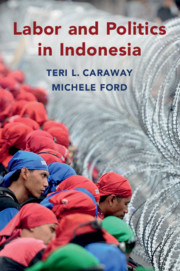Book contents
- Labor and Politics in Indonesia
- Cambridge Studies in Contentious Politics
- Labor and Politics in Indonesia
- Copyright page
- Contents
- Figures
- Tables
- Acknowledgments
- Abbreviations
- 1 Introduction
- 2 The Street and the Ballot Box
- 3 National and Local Policy Struggles, 1998–2008
- 4 Shifting to Offense
- 5 Local Executive Races
- 6 Legislative Contests
- 7 Building a Working-Class Constituency
- 8 Conclusion
- References
- Index
- Cambridge Studies in Contentious Politics
2 - The Street and the Ballot Box
Published online by Cambridge University Press: 02 March 2020
- Labor and Politics in Indonesia
- Cambridge Studies in Contentious Politics
- Labor and Politics in Indonesia
- Copyright page
- Contents
- Figures
- Tables
- Acknowledgments
- Abbreviations
- 1 Introduction
- 2 The Street and the Ballot Box
- 3 National and Local Policy Struggles, 1998–2008
- 4 Shifting to Offense
- 5 Local Executive Races
- 6 Legislative Contests
- 7 Building a Working-Class Constituency
- 8 Conclusion
- References
- Index
- Cambridge Studies in Contentious Politics
Summary
This chapter examines the forces that produced Indonesia’s highly mobilized but politically independent labor movement. It describes the authoritarian legacies that shaped the first phase of its evolution when the labor movement had no choice but to use street politics as its primary weapon in the struggle for more worker-friendly labor policy. In a second phase, new opportunities opened by the decentralization process led unions to experiment with electoral engagement. The focus of these efforts was at the local level where union activists backed executive candidates from many different parties, pragmatically trading their political support for pro-labor measures. In a third phase, unions drew on their past organizational learning and experimentation to extend their electoral engagement to the legislative arena. Reluctant to tie themselves directly to a single party, union strategists chose to place union cadres on legislative tickets of many different political parties. Autonomous electoral participation now complemented street politics as central features of labor’s political strategy.
Keywords
- Type
- Chapter
- Information
- Labor and Politics in Indonesia , pp. 29 - 47Publisher: Cambridge University PressPrint publication year: 2020

